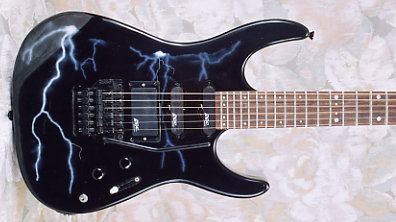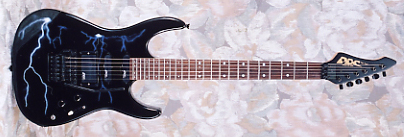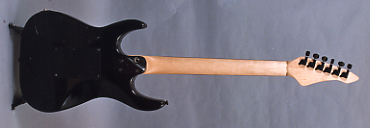How often have you ever walked into a music store—an admittedly increasingly exotic experience in this internet age—and had the salesman practically beg you to buy a guitar at a bargain basement price? My guess is not often! Nevertheless, that’s exactly what happened to me with this 1990 PBC GTS 200S!

1990 PBC GTS 200S Electric Guitar
The usual scenario, of course, involves holding onto a poker face, disguising your interest in some treasure or other, and finally ending up in a negotiation to wrangle the prize at the best—that is lowest—price. Not this time. I was casually cruising through Cintioli Music in Philadelphia, a legendary music store, when a salesman who knew me said “Psst,” and pointed to this guitar sitting on a stand on the counter. “Take this off my hands, please.” I shrugged. I had no idea what it was. Then he said the magic words. “Seventy five bucks.” Well, it did have a cool lightning bolt and the original hardshell case. What the hey. It was mine. Another mystery to solve…
It turned out that this guitar featured some very cool technology, had a really interesting pedigree, and was actually a local product built—in nearby Coopersburg, Pennsylvania—by a significant guitar designer, Dave Bunker. Yes, of the Boston Bunkers, though some generations and a century or so removed to the Pacific Northwest.

1990 PBC GTS 200S Electric Guitar
Dave was born on January 3, 1935, in Bunker Creek, Washington (his family has a knack for naming places). His was a musical family and he learned guitar and began teaching in Puyallup. Then in 1955 he went to one of those promotional workshops Gretsch was throwing starring the Ohio-born tapping-style genius Jimmie Webster. Bunker had his mission.
Bunker went on to have several successful music acts playing Las Vegas and later cruise ships. He designed the guitars for his act and Bunker guitars are some of the coolest unique guitars in guitar history. All were designed to maximize his “touch” technique. Detachable wings off a central core body, six individual pole pickups. Eventually leading to his “Touch Guitar.” Locking nuts and butt-end tuners? Dave. But those are all ancillary to this story!

1990 PBC GTS 200S Electric Guitar
Probably the central theme of Dave Bunker’s guitar contributions was his development of the “tension-free” neck in the 1960s. Bunker found that he was getting dead spots above the 10th fret caused by the tightening of the truss rod, which anchored right around there. He came up with the notion of taking all the tension off the neck by putting a metal bar into a channel through the neck, attaching the bar to the body and the head, leaving the neck itself to float free and be more resonant. Good for tapping!
The tension-free neck would provide the basis for all of Bunker’s subsequent guitar designing.
In 1989 while demonstrating his Touch Guitar at the Los Angeles NAMM show, Bunker met John Pearse, the colorful guitarist and string/accessory maven living in Pennsylvania. While performing on a cruise ship in Alaska the following year, Pearse contacted Dave about joining a new guitar manufacturing venture. With a partner named Paul Chernay to handle financing, Bunker found himself in charge of design and production of guitars for PBC Guitar Technology—Pearse-Bunker-Chernay—located just outside Bethlehem, Pennsylvania, about 50 miles north of Philly. Pearse quickly left the partnership over a disagreement.

1990 PBC GTS 200S Electric Guitar
In any case, the result was a line of interesting, mostly hollowbody guitars with Bunker-designed pickups…and the patented tension-free neck. The PBC line met with moderate success, but PBCs came into being at a time when retro guitars and, ironically, the Seattle sound were hitting big. Still, things really began to take off when Bunker’s guitars were discovered by Jim Donahue, then designing guitars for Ibanez in nearby Bensalem, Pennsylvania. Ibanez contracted with PBC to make its USA Custom USRG Series with Bunker’s floating necks, a line that debuted in 1994. Ibanez was pleased with the project and wanted to expand the relationship in 1996. However, Chernay had issues with working with the Japanese, and deep-sixed the contract. And, as it happened, PBC, which bit the dust along with the USRGs that year.
Probably the most conventional-looking guitar in the PBC line was this GTS 200S, with its Strat-style solid body. There was a GTS 200, the same except without the lightning graphics. Nevertheless, it had the tension-free neck, plus the quite-respectable PBC Spectrutone humbucker and two PBC Banshee singles. Not to mention a “sound reflection shield,” a recessed Kahler Spyder vibrato, and a coil-tap on the ‘bucker. A two-octave neck is never bad! Turns out this is one heck of a shred machine! Good price, too! This guitar originally listed for $900! It’s pretty much in like new condition.
And probably pretty rare. PBC output never got that large, and this model was only made for a couple of years.
After the PBC and Ibanez fiasco, Dave Bunker—now in his 70s—moved back to his native Washington State and began custom building Bunker guitars again, making guitars more-or-less based on his PBC designs. He’s still doing it today.
So, that salesman’s “Psst” worked out pretty good! Cool guitar. Cool piece of history. Like I said, a great price! And no negotiations. Glad I listened.

Hey, Michael, I agree with you completely on the PBC guitars….I have a ca. 1990 Telestyle PBC and this thing just won’t go out of tune and it sustains forever….it was an Ebay score a couple years ago, and I gotta send it to Phil Bunker to get it overhauled and restored……thanks for a great history!
I’ve got the same one! In 1990 or so i worked in a little musicshop in Dordrecht, the Netherlands and the owner imported a few PBC guitars, including this one. Because he didn’t have enough cash to pay my salary, he offered me to shop for free to the amount he owed me. So i left for home with this guitar, and a great secondhand marshall stack and a few effect pedals. Still enjoying this guitar till today! Greetings from Holland, Jeroen.
Hey all! My name is Laura, and I spent my teenage summers working in my grandfather’s guitar shop — PBC! (He was the “C” in PBC.) If you bought your PBC guitar from the shop in Coopersburg, I probably handled it, and you might have even met me! I am so delighted to read such a positive review of the instruments built with such craftsmanship and pride. I was sad to see it go. Dave was certainly a character, and Bob, Tommy V., Rob and Billy the Painter were the best crew. PS If anyone wants to sell ME a PBC for $75, I’m always looking for old friends! Thanks for refreshing old memories.
Good post. I was reviewing regularly this website and I am pleased! Helpful data specially the staying segment 🙂 I look after like information a whole lot. I was seeking that a number of details for some time. Thanks and all the best !.
I worked for PBC and I was the one who sold that guitar to Cintiolis.
Don’t know if y’all still around or not but anyway I bought my GTS 200 from your shop in Coopersburg probably like 1991 maybe 92 all I do know is I was 16 years old when I bought it and I’m 41 now and it’s still my favorite guitar that I own and my fondest memorie of the old shop is when I came in to check out your product was Dave I had never seen one of those touch guitars I had asked Dave what it. Was so he picked one up and he blew my mind the next thing I did was put money down on my guitar and went to George’s music to cancel out on the Ibanez USA Custom that I was going to buy so glad I did . well just one more thing if u still have a shop please contact me I wood like to maybe have y’all give it a little touch up P.S. THANKS FOR ALL THE YEARS OF FUN
In the early 90s I got my first amp from Dave ! Me and my dad went there often just to talk to him truly a great person.
And today, after thirty years of schredding, I sold it. Made a great deal, but a bit sad to see it go….
Picked up a tele style pbc at Coopersburg, nice green finish, they said it belonged to Eddie Rabbits guitarist, stacked Lawrence pickups, still my go to axe, thanks